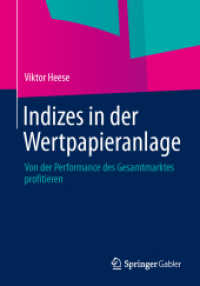- ホーム
- > 洋書
- > 英文書
- > History / World
Full Description
The Establishment Clause of the First Amendment governs the relationship between the institutions of the church and those of the state; the Supreme Court, as arbiter of the Constitution, has, since 1947, sought to determine where the line between the two should be drawn. The Church-State Debate shows how and why the Court drew the line in particular cases and how and why the lines that were drawn by the Court had an impact on the relationship between institutions of government and the Church, shaping US politics and society.
Using the Supreme Court's cases as a framework, Emma Long demonstrates how the constitutional underpinnings of church-state debates shaped the political, economic, and social debate on the issue, and explores broader debates about religion and American society. She maintains that the Court cases cannot be understood separately from the context from which they arose and that legal factors are only part of a broader picture for a historical understanding of the Court and Establishment Clause cases.
Contents
Introduction
Part I: School Aid
1. The Beginnings: Everson and Allen
2. Reassessing the Burger Court
3. Accommodation Triumphant? The Rehnquist Court
Part II: School Prayer
4. Engel and Schempp: Controversy and Compliance
5. School Prayer and the Reagan Era
6. All Change? The Rehnquist Court
Part III: Equal Access
7. The Issue Emerges: Widmar and the Equal Access Act
8. The Court United and Divided: The Path to Rosenberger
Conclusion
Bibliography
Index








